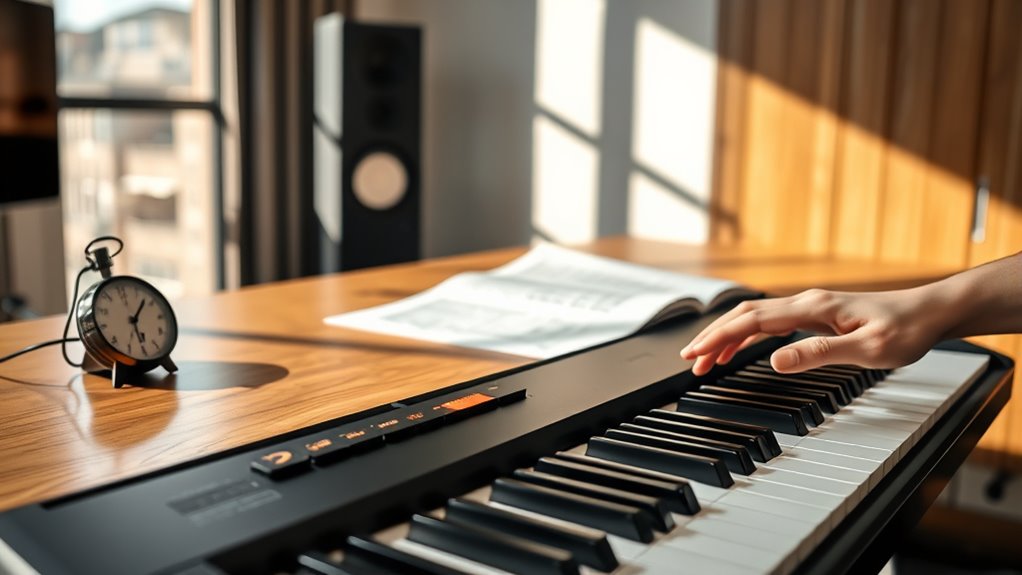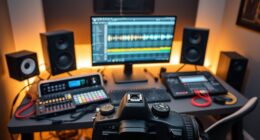To fit effective rhythmic dictation exercises into 10 minutes, start with simple patterns like quarter and eighth notes. Use a metronome to maintain steady tempo, then gradually add complexity with syncopation and rests. Focus on recognizing note groupings, accents, and timing variations. Repeating these exercises regularly strengthens your internal sense of rhythm and improves accuracy. Keep practicing these quick drills, and you’ll discover how small, consistent efforts boost your musical fluency over time.
Key Takeaways
- Start with simple rhythmic patterns, gradually increasing complexity to build accuracy and confidence quickly.
- Use a metronome to maintain steady tempo while practicing different rhythms within 10 minutes.
- Incorporate tempo variations and syncopation exercises to enhance rhythmic flexibility and adaptability.
- Focus on internalizing note groupings, rests, and accents to improve sight reading and internal rhythm.
- Repeat exercises regularly to reinforce internal timing and develop a reliable sense of rhythm in a short time.
Effective 10-Minute Rhythmic Dictation Practice

Have you ever struggled to internalize complex rhythms when learning music? If so, rhythmic dictation exercises can be a game-changer. In just ten minutes, you can sharpen your ability to recognize and reproduce intricate rhythmic patterns. One effective way to do this is by focusing on sight reading techniques. As you practice, you’ll learn to quickly interpret rhythmic notation, which enhances your overall fluency. Start with simple patterns, then gradually introduce more complex ones. Pay attention to note groupings, rests, and accents, as these are essential for accurate dictation. Sight reading isn’t just about decoding notes; it’s about internalizing rhythms so they become second nature. When tackling rhythm exercises, don’t forget to contemplate tempo variations. Playing rhythms at different speeds challenges your internal clock and helps you adapt to diverse musical contexts. Begin by practicing at a comfortable tempo, then speed up or slow down as you become more confident. This flexibility is indispensable for developing a keen sense of timing and rhythm consistency. Incorporate exercises that include changes in tempo within a single pattern, which trains you to maintain accuracy despite fluctuating speeds. As you listen and transcribe, focus on how tempo shifts influence the feel of the rhythm. Are the notes played faster or slower? How does that change the overall groove? Experimenting with tempo variations also improves your ability to anticipate rhythmic shifts, a skill essential for ensemble playing or improvisation. To make your practice more effective, use a metronome to control the tempo and introduce subtle variations. This way, you’ll learn to keep steady time, even when the backing track speeds up or slows down unexpectedly. Over time, these adjustments will become intuitive, helping you to stay in sync with other musicians. Remember to start with straightforward patterns and gradually increase the complexity. Repetition is key—repeating rhythmic dictations strengthens your internal sense of timing and accuracy. As you get comfortable, challenge yourself with syncopated rhythms or irregular patterns to push your skills further. Ultimately, the goal is to develop a flexible, reliable internal rhythm that can adapt to any musical style or tempo change. Practicing with tempo variations and incorporating sight reading techniques will further enhance your rhythmic versatility. By dedicating just ten minutes to focused rhythmic dictation, incorporating sight reading techniques, and practicing tempo variations, you’ll notice a tangible improvement in your rhythmic precision. Consistent practice will help you internalize rhythms more effortlessly, making your overall musicianship stronger and more confident.
Frequently Asked Questions
Can Beginners Successfully Do These Rhythmic Dictation Exercises?
You might wonder if beginners can succeed with rhythmic dictation exercises. The truth is, yes, they can, especially when you focus on building your music theory and ear training skills gradually. These exercises help you recognize patterns and improve timing. With consistent practice, even newcomers can develop confidence and accuracy. Just start with simple rhythms, stay patient, and you’ll notice progress as you strengthen your musical ear and understanding.
What Equipment or Tools Are Needed for Practice?
Imagine opening perfect rhythm—what tools will get you there? You’ll need a metronome app to keep steady tempo and printable worksheets to practice note patterns. These simple, accessible tools make your sessions engaging and effective. With just a smartphone or tablet and some paper, you’re ready to plunge into rhythmic dictation. Stay consistent, and you’ll see progress faster than you imagined. Ready to get started?
How Often Should I Practice for Noticeable Improvement?
To see noticeable improvement, you should practice consistently, ideally daily or at least several times a week. Maintaining regular practice helps build your skills faster. Focus your mental energy during each session, staying attentive and engaged. This combination of practice consistency and mental focus accelerates your progress, making your rhythmic dictation skills sharper over time. Even short, focused sessions can yield great results if done regularly.
Are There Specific Genres of Music to Focus On?
Imagine you’re a jazz musician in the roaring ’20s, honing your skills. Focusing on genres like jazz, classical, or pop helps deepen your understanding of music theory and rhythm analysis. These styles offer diverse rhythmic patterns that challenge and improve your ear. By concentrating on specific genres, you’ll develop a more refined sense of timing and groove, making your rhythmic dictation exercises more effective and enjoyable.
How Do I Evaluate My Progress Effectively?
To evaluate your progress effectively, use self-assessment techniques like recording your rhythmic dictation practice and listening back critically. Track your progress with simple methods such as maintaining a practice journal or using progress charts. Regularly compare your current recordings to earlier ones to spot improvements. This consistent progress tracking helps you stay motivated and identify areas needing more focus, ensuring steady growth in your rhythmic skills.
Conclusion
In just 10 minutes, rhythmic dictation can become your secret weapon, sharpening your musical ear like a finely tuned instrument. By practicing regularly, you’ll notice your ability to recognize and reproduce rhythms improves steadily—like a painter refining their brushstrokes. Even on busy days, dedicating a brief moment to these exercises makes a big difference. So, grab a metronome and immerse yourself; your rhythmic skills will thank you for the boost.










